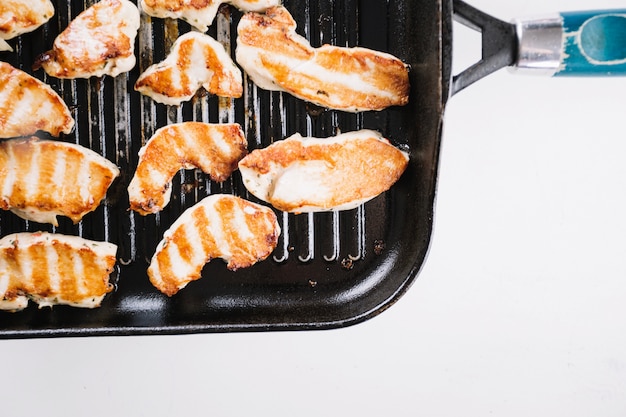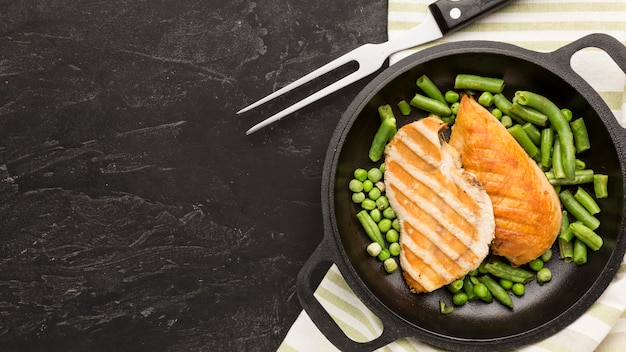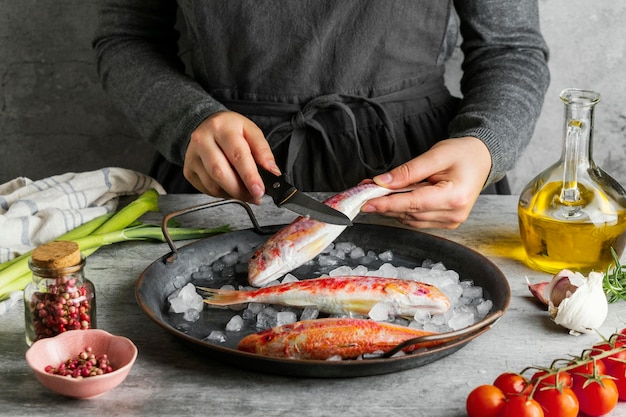Oh, pan-seared salmon. It’s a culinary masterpiece, a symphony of textures and flavors that always leaves me craving more. The crisp, golden skin, the tender, juicy flesh – it’s a simple yet utterly satisfying dish. But achieving that perfect pan-seared salmon, that elusive golden perfection, can be tricky. You might end up with a dry, overcooked fish, or worse, a sticky mess stuck to the pan. But fear not, my friends, for I’ve been there, and through countless trials and a few burnt offerings, I’ve mastered the art of the pan-seared salmon. Let me share my secrets with you, and together, we’ll conquer the art of pan-searing salmon.
(Part 1) choosing the right salmon: The Foundation of Success

Before we even think about firing up the pan, it’s crucial to choose the right salmon. You’re not just grabbing any old fish here; you’re selecting the star of the show, the foundation of your delicious meal. The quality of your salmon makes a huge difference in the final product.
Picking the Perfect Cut: Skin-On is Your Friend
Personally, I always go for skin-on salmon fillets. It’s just so easy to cook and the skin acts like a protective barrier, preventing the fish from sticking to the pan. It’s a game-changer, I tell you. You get that perfectly crisp skin and perfectly cooked flesh. If you’re feeling adventurous, try a salmon steak, a thicker, heartier cut. But for beginners, I highly recommend starting with a skin-on fillet.
The Freshness Factor: A Guide for Your Nose
Now, let’s talk about freshness. The key is to find fresh, firm salmon. How do you know it’s fresh? A good sniff test is a great first step. A fresh salmon will have a mild, slightly sweet smell, not a fishy or ammonia-like aroma. If it smells even remotely off, walk away. The gills are another telltale sign. They should be bright red and firm, not dull or mushy.
The Colour Code: A Visual Cue to Quality
Finally, look at the color. A good piece of salmon will have a vibrant, even color – think deep orange or pink, depending on the type of salmon. Avoid any salmon that’s pale, pale pink, or has a greyish tint. Those are signs of a less fresh fish. And trust me, you want fresh salmon.
(Part 2) Prepping the Salmon: Bringing Out the Best in Your Fish

Okay, you’ve got your hands on a stunning piece of salmon. It’s time to prep it, to unleash your inner chef and really bring out the best in your chosen fish.
Pat It Dry, Pat It Dry: The Key to crispy skin
The first step is to pat the salmon dry with some kitchen paper. This might seem like a minor detail, but it’s a big deal. Moisture on the skin will stop it from getting that gloriously crisp sear. So, get those paper towels out and give it a good pat down. You want it nice and dry.
Seasoning for Success: Flavourful Salmon
Now, let's talk flavour. While salt and pepper are always a good choice, I like to add a touch of extra magic to my salmon. My go-to seasoning is a mix of salt, pepper, paprika, and a pinch of cayenne for a little kick. But feel free to get creative. Lemon zest, garlic powder, even a bit of brown sugar for a caramelized finish – let your culinary imagination run wild!
Let It Rest: Time for the Flavors to Infuse
Once your salmon is seasoned, give it a short rest. Pop it in the fridge for 10-15 minutes. This allows the flavors to infuse into the salmon and also prevents it from sticking to the pan during cooking.
(Part 3) The Pan and the Heat: Setting the Stage for Success

We’re almost ready to cook! Now comes the crucial decision: the pan and the heat. These are the key ingredients for achieving that perfect pan-seared salmon. Don’t worry, I’m here to guide you.
Choosing the Right Weapon: Cast Iron is King
First, the pan. My trusty sidekick for pan-searing salmon is a cast iron pan. It heats up evenly and retains heat like a champion, crucial for creating that beautiful sear. But if you don't have a cast iron pan, a heavy-bottomed stainless steel pan will do just fine.
Heat It Up: High Heat is Your Ally
Next, heat your pan over high heat. We’re talking high, high heat, the kind that makes your kitchen feel like a sauna. You want that pan scorching hot before you even think about adding the salmon. Why? Because if the pan isn't hot enough, the salmon will steam instead of sear, and we don’t want that, do we?
Oil It Up: A Lubricant for Deliciousness
Once your pan is screaming hot, add a generous amount of oil. Olive oil is my personal favorite, but avocado oil or grapeseed oil will do the trick too. The goal is to have enough oil to coat the bottom of the pan, creating a nice, even layer, but not so much that the salmon is swimming in it.
(Part 4) The Searing Process: Creating that Golden Crust
And now, the moment of truth! It’s time for the actual searing. This is where we get those gorgeous golden brown sear marks and lock in all that delicious flavor.
Patience is a Virtue: Let It Sear
Carefully place the salmon, skin-side down, into the hot pan. Don’t move it for at least 3-4 minutes. Give it time to develop that beautiful, crispy skin. This is the moment to exercise patience. Let it sear undisturbed and resist the urge to fiddle with it. Trust me, it's worth the wait.
Flip It: Don't Forget the Other Side
After 3-4 minutes, gently lift a corner of the salmon. If the skin comes off easily and the flesh is cooked to a nice, opaque white along the edges, then it’s time to flip. If not, let it cook for a little longer. Gently flip the salmon, being careful not to break the skin. Cook the other side for another 2-3 minutes, depending on the thickness of the salmon.
(Part 5) Checking for Doneness: Ensuring Perfection
We’re getting close to perfectly pan-seared salmon, but how do we know it’s actually cooked through? There are a few simple ways to check.
The Poke Test: A Simple Guide to Texture
The most straightforward way is to use the poke test. Gently press the thickest part of the salmon. If it feels firm and gives a little resistance, it’s likely cooked through. If it feels mushy or jiggly, it needs a few more minutes.
The Internal Thermometer: Precise and Reliable
If you’re feeling extra cautious or want a more precise reading, use a meat thermometer. Salmon is cooked through when it reaches an internal temperature of 145°F (63°C).
(Part 6) Rest, Relax, and Serve: The Final Touches
Your salmon is cooked! Pat yourself on the back, you’ve done it! But don’t rush to serve it just yet. Give the salmon a well-deserved rest. Let it sit for 5-10 minutes before serving. This lets the juices redistribute throughout the fish, preventing it from becoming dry.
Serving Ideas: From Simple to Spectacular
And now, the moment we’ve all been waiting for: serving time! Pan-seared salmon is incredibly versatile. It pairs beautifully with a simple salad, roasted vegetables, or mashed potatoes. For a touch of elegance, serve it with a creamy lemon sauce, a light, herby dressing, or a zesty salsa.
(Part 7) Mastering the Art of the Sear: Fine-Tuning Your Technique
You’ve learned the basics, but let’s talk about mastering that perfect sear, that golden crust that elevates pan-seared salmon to culinary greatness.
High Heat: The Secret to That Crispy Skin
Remember, high heat is our best friend. If you don’t have enough heat, the salmon will steam instead of sear, resulting in a soggy texture. So, crank up the burner!
Avoid Overcrowding: Give Each Piece Its Space
Another crucial tip is to avoid overcrowding the pan. If you cram too much salmon into the pan, it will steam instead of sear. The ideal scenario is to have enough space between each piece of salmon for the heat to circulate evenly.
Don't Touch It: Resist the Urge to Interfere
I know it's tempting, but try your best to resist the urge to move the salmon around too much during the initial searing. It’s a waiting game, but give it time to develop that beautiful crust. Resist the urge to flip it before it’s ready, and you’ll be rewarded with a perfectly cooked, crispy-skinned salmon.
(Part 8) Troubleshooting Common Problems: Addressing the Unexpected
Okay, let’s be real. Sometimes things don’t go as planned. But don't worry, we’ve all been there. Let's troubleshoot those common pan-seared salmon problems together.
The Salmon Sticks: A Case of Insufficient Heat
You place your perfectly prepped salmon in the pan, and it’s like it’s glued to the surface. This usually happens if the pan wasn’t hot enough or if the salmon wasn’t patted dry. To fix this, try to gently loosen the salmon from the pan with a spatula and allow it to continue cooking for a few more minutes. If it’s still stuck, add a tablespoon or two of water to the pan and let it steam for a minute before carefully lifting it out.
The Skin Doesn't Crisp: A Matter of Heat and Moisture
We all want that beautiful, crispy skin. But sometimes, it just doesn’t happen. If the skin doesn’t crisp up, it could be because the pan wasn’t hot enough, the salmon was too wet, or it's just a stubbornly resistant piece of skin. The best way to get a crispy skin is to make sure the pan is scorching hot and the salmon is thoroughly dried before searing.
The Salmon is Dry: Overcooking is the Culprit
This is a real bummer. overcooked salmon can be dry and tough. To avoid this, make sure you don't overcook your salmon. Use the poke test or a meat thermometer to check for doneness, and always rest the salmon after cooking to allow the juices to redistribute.
FAQs: Answers to Your Burning Questions
Now, let’s address some of the most common questions about pan-searing salmon.
A cast iron pan is ideal for pan-searing salmon because it heats up evenly and holds heat well. A heavy-bottomed stainless steel pan will also work.
Use a high-heat oil, like olive oil, avocado oil, or grapeseed oil. Make sure to use enough oil to coat the bottom of the pan, but not so much that the salmon is swimming in it.
The searing time will depend on the thickness of the salmon. For a 1-inch thick salmon fillet, sear for 3-4 minutes per side. The key is to achieve a beautiful golden brown crust.
Use the poke test: Gently press the thickest part of the salmon. If it feels firm and gives a little resistance, it's likely cooked through. If it feels mushy or jiggly, it needs a few more minutes. Alternatively, you can use a meat thermometer. Salmon is cooked through when it reaches an internal temperature of 145°F (63°C).
If the salmon sticks to the pan, try to gently loosen it with a spatula. If it’s still stuck, add a tablespoon or two of water to the pan and let it steam for a minute before carefully lifting it out.
Everyone is watching

Prime Rib Roast Cooking Time Chart: Per Pound Guide
Cooking TipsPrime rib roast. Just the name conjures images of lavish dinners, crackling fires, and hearty laughter. It’s ...

How Long to Bake Potatoes in the Oven (Perfect Every Time)
Cooking TipsBaked potatoes are a staple in my kitchen. They're incredibly versatile, delicious, and surprisingly easy to m...

Perfect Rice Every Time: The Ultimate Guide to Cooking Rice
Cooking TipsAs a self-proclaimed foodie, I've always been a bit obsessed with rice. It's the foundation of countless cuisi...

The Ultimate Guide to Cooking Asparagus: Tips, Techniques, and Recipes
Cooking TipsAsparagus. The mere mention of this spring delicacy conjures up images of vibrant green spears, crisp and burs...

Ultimate Guide to Cooking the Perfect Thanksgiving Turkey
Cooking TipsThanksgiving. Just the word conjures up images of overflowing tables laden with delicious food, the scent of r...
